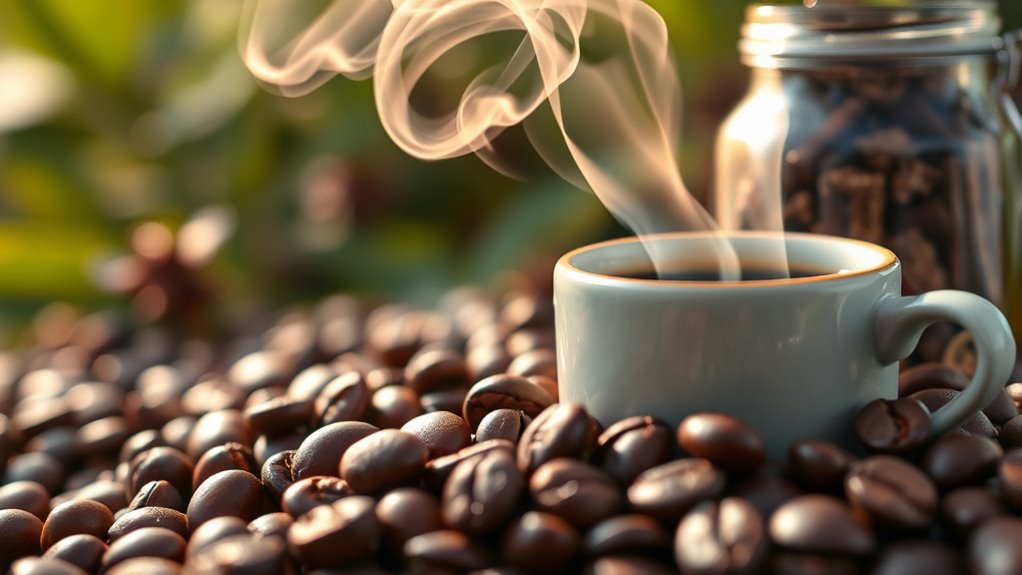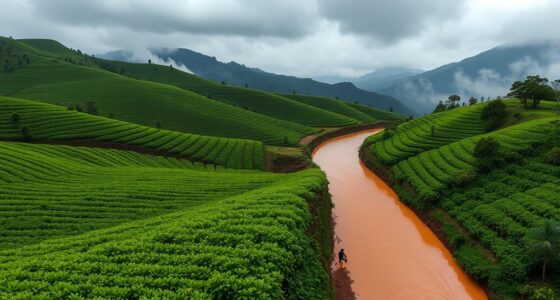Coffee’s aromatic richness comes from over 850 volatile compounds formed during roasting and brewing. These compounds arise through complex reactions, including the Maillard reaction, which enhances flavors. Factors like coffee variety, altitude, and processing methods play essential roles in shaping aroma. Roasting levels also contribute, with light roasts preserving original scents and dark roasts developing deeper notes. To better appreciate these aromatic nuances, you’ll want to explore the various influences and techniques that enhance your coffee experience.
Key Takeaways
- Coffee’s aroma arises from over 850 volatile compounds generated during roasting and brewing, significantly influenced by the Maillard reaction.
- The variety of coffee beans, particularly Arabica, along with altitude and processing methods, plays a crucial role in developing unique aromatic profiles.
- Grinding coffee beans releases aromatic compounds, enhancing the overall brewing experience and ensuring a richer aroma.
- Roasting levels affect aroma characteristics; light roasts maintain original flavors, while dark roasts introduce deeper, more complex scents.
- Proper storage techniques in airtight containers preserve the integrity of coffee’s aroma, ensuring a fresh and enjoyable sensory experience.
Understanding Aroma in Coffee

When you take a moment to inhale the aroma of freshly brewed coffee, you’re experiencing a complex blend of over 850 volatile compounds that develop during roasting and brewing.
Inhaling the aroma of freshly brewed coffee reveals a complex blend of over 850 volatile compounds developed during roasting and brewing.
This rich coffee aroma is a sensory experience shaped by the Maillard reaction, where amino acids and sugars interact to create distinctive fragrances.
As you grind your beans, the dry aroma reveals the initial flavor profile, while the brewing process introduces the wet aroma, releasing even more aromatic compounds.
Factors like coffee variety, altitude, and processing method—wet or dry—significantly influence these characteristics.
To maintain the integrity of your coffee’s aroma, proper storage techniques, such as using airtight containers and minimizing exposure to air, light, and moisture, are essential.
Formation and Classification of Aromatic Compounds

The rich aroma of coffee you enjoy is a result of intricate chemical processes that unfold from the moment green coffee beans are harvested. The formation of aromatic compounds begins with the accumulation of amino acids, sugars, and lipids, all essential during the roasting process.
This stage triggers complex chemical reactions, producing various volatile compounds, including aldehydes, ketones, and esters. The Maillard reaction, involving amino acids and reducing sugars, greatly contributes to the diverse aromatic profile of roasted coffee.
As you grind the beans, these aromatic compounds are released and extracted during your brewing method, enhancing your coffee experience. Different coffee varieties and processing methods can alter the classification of these aromatic compounds, making each cup unique.
Factors Influencing Coffee Aroma

While many factors shape coffee’s aroma, the variety of the bean is one of the most significant influences. Arabica beans typically offer a more complex flavor profile with nuanced aromas compared to Robusta.
The variety of coffee beans, especially Arabica, greatly impacts aroma and flavor complexity.
Altitude also plays an essential role; higher elevations yield coffee beans with brighter acidity and refined aromatic characteristics due to slower maturation.
The processing method affects the development of volatile compounds; wet processing often results in cleaner, vibrant aromas, whereas dry processing can lead to richer scents.
Roasting levels further impact aroma, as light roasts preserve original characteristics while dark roasts develop deeper scents through the Maillard reaction.
Finally, environmental factors like soil composition and climate contribute unique flavor notes, enhancing the allure of specialty coffee.
Evaluating Coffee Aroma

Evaluating coffee aroma is essential for truly appreciating each cup’s unique characteristics. When you assess a coffee’s aroma profile, you’re looking for complexity, which reflects the diversity of over 850 identified aromatic compounds.
Intensity plays a vital role, as it indicates how strong these volatile compounds are, affecting your overall experience. Smoothness refers to how well the various aromatic notes blend, creating a harmonious scent that enhances enjoyment.
Don’t forget about the linger of aroma; the duration of scent after sipping can greatly influence your perception of flavor.
To optimize your evaluation, focus on proper brewing techniques, like using freshly ground beans, ideal water temperature, and the right coffee-to-water ratio to reveal the full potential of your coffee’s aroma.
Optimizing Aroma for an Enhanced Experience

To truly elevate your coffee experience, optimizing aroma is key. Start by using freshly ground coffee beans, as grinding maximizes the surface area and helps volatile compounds are released when hot water extracts them during brewing.
Focus on proper brewing techniques, ensuring your water temperature ranges between 195-205°F. Experiment with different methods like Pour Over or Espresso to discover how each highlights unique aromatic profiles that enhance flavor complexity.
Store your beans in an airtight container in a cool, dark place to maintain their quality and aroma over time.
Finally, take a moment to inhale the enchanting aroma of coffee before sipping; this practice enriches your sensory experience, allowing you to fully appreciate the aromatic qualities.
Frequently Asked Questions
Why Does Coffee Have a Strong Smell?
Coffee has a strong smell due to the release of over 850 volatile aroma compounds during roasting and brewing.
As you grind the beans, you’ll notice the dry aroma, which evolves into a rich wet aroma once brewed.
Factors like the coffee variety, processing methods, and roasting levels all contribute to this complexity.
When you brew your coffee properly, using the right temperature and fresh beans, you maximize these aromatic compounds for an unforgettable experience.
How Do You Make Coffee More Aromatic?
To make your coffee more aromatic, start with freshly ground beans, as they release essential compounds that enhance aroma.
Experiment with different brewing methods like French Press or Pour Over to highlight various notes.
Store your beans in an airtight container away from light and moisture to keep them fresh.
Adjust brewing parameters, like water temperature and coffee-to-water ratio, and take a moment to smell the dry grounds before brewing for a richer experience.
What Is the Aroma Chemical in Coffee?
The aroma in coffee comes from a mix of over 850 volatile compounds, including aldehydes, ketones, and esters, created during roasting.
Key reactions, like the Maillard reaction, generate distinctive compounds such as pyrazines that enhance the smell.
When you brew coffee, hot water helps extract these aromatic compounds, intensifying the fragrance.
Why Is the Smell of Coffee so Relaxing?
The smell of coffee wraps around you like a warm blanket on a chilly morning.
It’s relaxing because it’s packed with compounds that trigger dopamine release, giving you that cozy, pleasurable feeling. Your brain’s limbic system processes these aromas, connecting them to comforting memories.
Inhaling that rich scent can even lower stress and blood pressure, making each whiff a mini escape from daily chaos.
Conclusion
In the end, you’ve discovered that coffee’s aroma is a complex dance of compounds formed during roasting and brewing. Each factor, from bean variety to brewing method, plays an essential role in crafting that enticing scent you love. By understanding these elements, you can reveal new dimensions in your coffee experience. So, next time you sip your brew, remember: it’s not just about taste; it’s about savoring the rich, aromatic journey that each cup offers.









